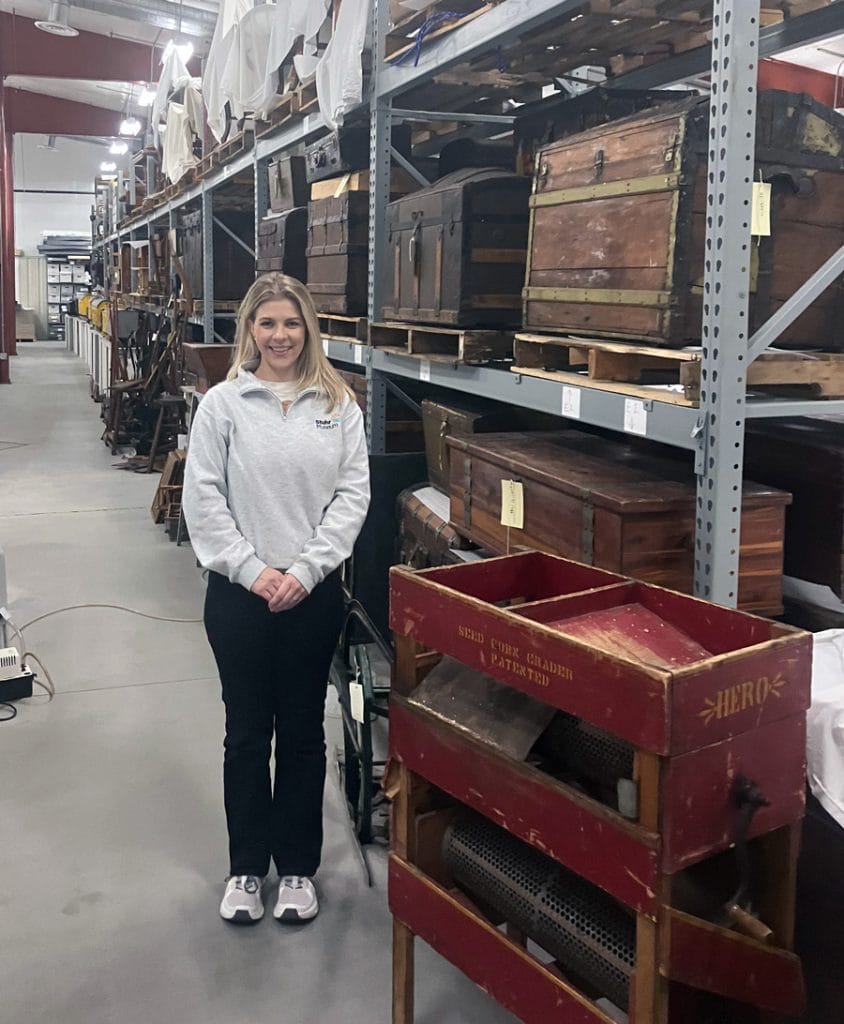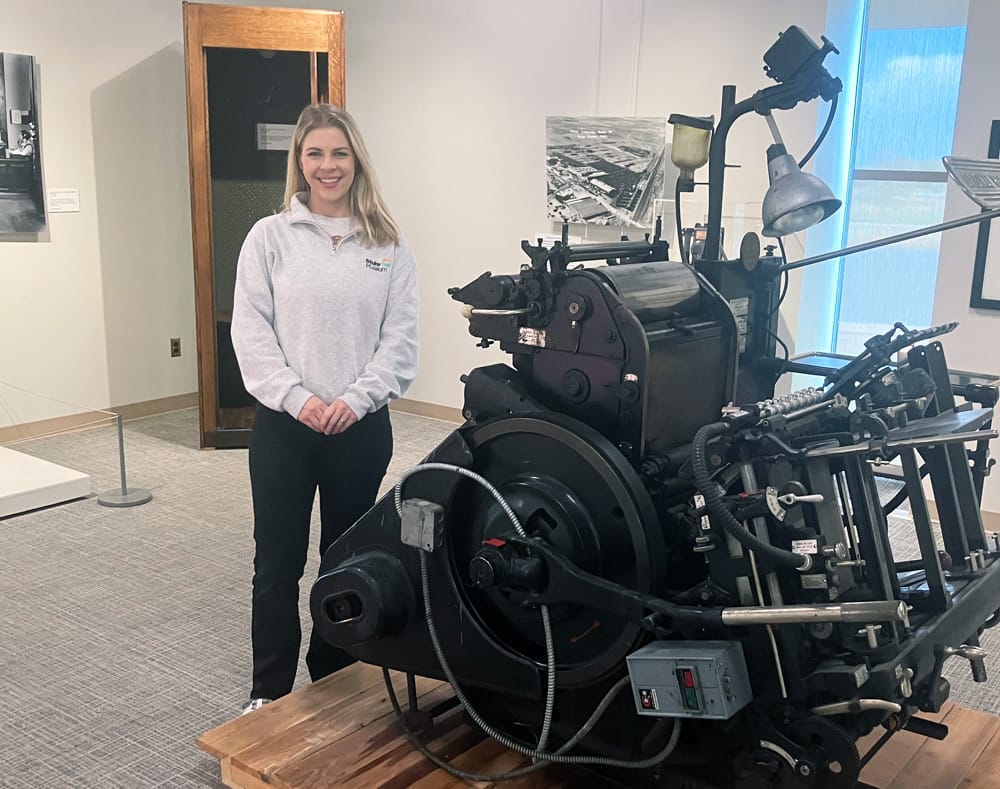Kylie (Luth) Christenson ’19 leads a visitor up the elegant curving staircase of the Stuhr Museum of the Prairie Pioneer in Grand Island, Nebraska. On the second level, she gestures toward a few artifacts lining the stark white walls — a printing press once used at the Hastings Tribune, a dog-powered treadmill that operated a corn sheller, a medieval-looking permanent wave device for curling women’s hair, even an iron lung.

In the South Gallery — a space for rotating exhibits of artifacts and fine art — she points out the diverse and vibrant watercolors of Omaha artist Telagio Baptista, an exhibit she facilitated and designed.
“We try to give visitors both historical and artistic exhibits,” said Christenson, a Cairo, Nebraska, native who graduated from Hastings College with a major in history and minor in art. “We like to give people a taste of everything.”
The museum’s director of exhibits and assistant curator since 2023, Christenson is both storyteller and interpreter, someone who brings the past to life in creative, engaging ways.
She manages the museum’s exhibit calendar, balancing rotating and semi-permanent displays that shape the visitor experience. Planning now stretches through 2028, including solo artist exhibits, historical features and “Wings Over the Platte,” a 2026 art exhibit celebrating the Platte River and the migration of 1.25 million Sandhill Cranes.
At times, Christenson works on events and exhibits in Stuhr’s Railroad Town, a collection of 1890s-era homes and businesses. Guests can buy a cone at the general store, see prairie town newspaper and post offices and watch tradesmen in the blacksmith and tinsmith shops. Many of the buildings are original artifacts relocated from sites in Grand Island.
“Stuhr has 140,000 artifacts. That includes all of the houses and buildings in Railroad Town,” she said.
Storytelling through exhibits
Christenson’s first independently planned exhibit, “Weathering the Storm: The Weather Events that Shaped Central Nebraska,” remains her favorite. On display in Spring 2025, it explored three defining weather events — tornadoes, blizzards and floods — through artifacts, photographs and narrative storytelling.

One section focused on the 1980 tornado outbreak in Grand Island, when a single supercell produced seven twisters, leaving five people dead and causing $300 million in damage. The display featured objects ravaged by the storm — a mangled teapot with the handle torn off, a twisted grounding stake and a bowling ball from Meves Bowl, destroyed that night. Longtime meteorologist Kent Boughton shared his memories of the disaster.
“That tornado destroyed all of South Locust Street,” Christenson said. “Looking at it today, you’d never know that. To me, it was important to bring that into the light again and show how the community stepped up to support each other, overcome and rebuild.”
She has worked on other popular exhibits, including “World War II on the Homefront,” and is planning future projects that blend art, history and community reflection.
“Museums today are trying to engage visitors more — with videos, tactile displays and interactive elements,” she said. “It can be as simple as asking visitors to share their thoughts on paper, so they can be part of the exhibit too.”
A path shaped by Hastings College
Christenson didn’t begin college hoping to work in museums. “Initially, I was dead set on archaeology,” she said.
Encouraged by history professor Dr. Rob Babcock to test the field before investing her time and money in graduate studies, she joined a summer dig in Mississippi at a Paleolithic Indian site.
“We were in the woods all day — bugs, snakes, no shoes — and I spent hours in a one-by-one-meter hole,” she said. “It was meticulous, tedious work, and I had scars from the bugs for months.”
When she returned, Babcock asked how it went. Her answer was simple: “You were right. I didn’t like it.”
Then he asked, “Have you ever thought about museum work? You get the cleaned-up version of what you were doing out there.”
That advice changed her direction. Christenson interned at the Stuhr Museum in collections and archives, where she learned about cataloging systems and exhibit preparation. She later interned at the Hastings Museum.
“Museums often have a lot of items in storage that no one gets to see,” she said. “I liked getting behind the scenes.”
After graduating, Christenson earned a master of public administration degree from Northern Arizona University. “The MPA helped me understand the administrative side of how nonprofits operate, which has been invaluable here. At the core, we’re small, and we’re all doing a lot of different things,” she said.
When she finished her degree, Stuhr hired her. Her husband, Ryan Christenson ’19, teaches social-emotional creative arts at Howard Elementary in Grand Island.
Asked what an exhibit about her Hastings College experience might look like, she paused thoughtfully.
“I feel like it should be a tribute to the orange room in McCormick,” she said, referring to the anteroom in the history department where students connect with professors and one another. “The history department was so supportive — Dr. Babcock, Dr. (Glenn) Avent, Dr. (Catherine) Biba. History isn’t just mundane, boring things like dingy books. It can be bright and can spark something in you.”
